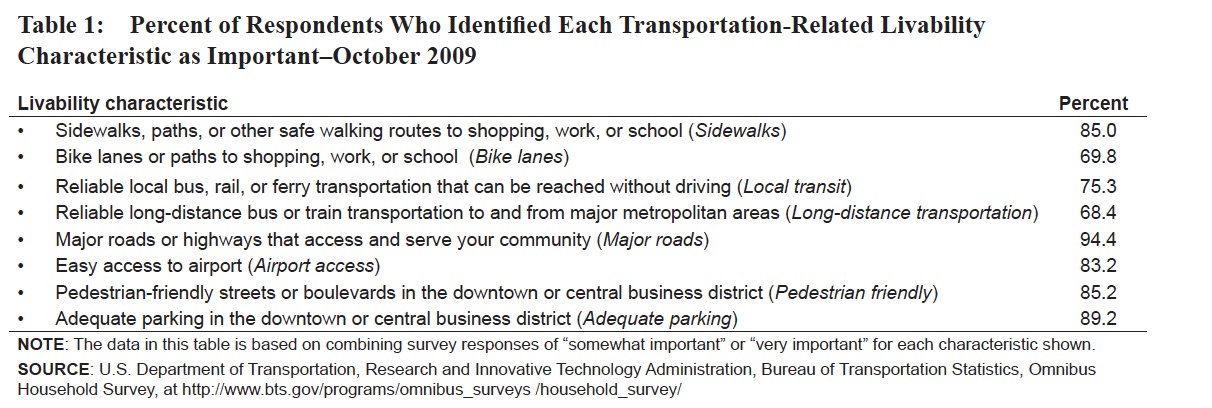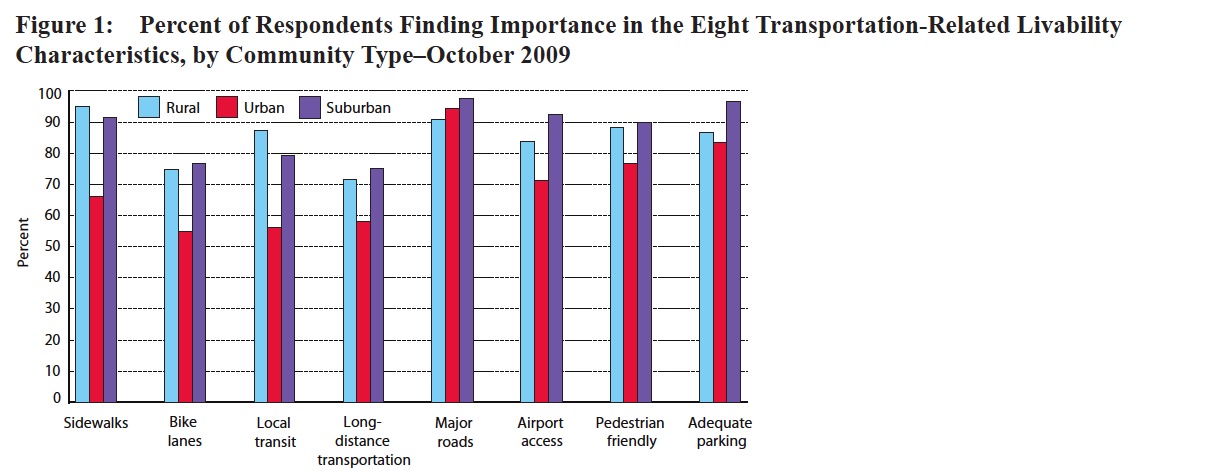RESEARCH AND INNOVATIVE TECHNOLOGY ADMINISTRATION
BUREAU OF TRANSPORTATION STATISTICS
by Jenny Guarino and Pheny Weidman, Ph.D.
The Omnibus Household Survey (OHS) is a national survey on attitudes about transportation that is administered annually by the Bureau of Transportation Statistics (BTS) to a sample of approximately 1,000 households (see box B). The 2009 OHS included a series of questions to gauge public perceptions on transportation-related characteristics of livable communities. Survey participants were asked to rate how important1 several transportation options or features were to have in their community, such as highway access, transit service, and bike lanes (see table 1).
Responses to the 2009 OHS suggest that a majority of the public considered it important to have a wide range of transportation alternatives. The majority also strongly supported the provision of facilities that permit continued reliance on the personal automobile in the community in which they live. This is illustrated by the following key findings from the OHS:
- 75 percent stated that reliable local bus, rail, or ferry transportation that could be reached without driving was important;
- 70 percent found importance in bike lanes or paths to shopping, work, or school;
- 94 percent said that major roads or highways that served their community were important; and
- 89 percent felt that adequate parking in the downtown or central business district was important.
2009 OHS Livability Analysis
Table 1 depicts the eight transportation-related livability characteristics included in the 2009 OHS.2 As seen in table 1, respondents found major roads or highways serving their community and adequate parking in the downtown or central business district to be the most important characteristics. While the presence of reliable long-distance bus or rail transportation, bike lanes, and local transit were rated important by the fewest people, these characteristics were still found to be important by over two-thirds of respondents. This report examines public opinion on these characteristics by community type as well as by age, gender, and income.
Community Type
To better understand how public perceptions varied by community type, respondents were asked to identify whether they resided in a rural, urban, or suburban community. Overall, 33 percent of respondents stated they lived in an urban setting, 39 percent resided in suburban areas, and 29 percent in a rural setting.4 Figure 1 shows the level of importance, in percent, that respondents associated with each of the eight livability characteristics. Nearly all (94 percent of respondents) felt that having major roads was important. It is notable that for most livability characteristics, the rural and suburban responses track very closely to one another—particularly bike lanes, long-distance transportation, and pedestrian-friendly streets.
About the Bureau of Transportation Statistics
www.bts.gov
“The BTS mission is to create, manage, and share transportation statistical knowledge with public and private transportation communities and the Nation. The main purpose of BTS’ work is to help advance the DOT Strategic Plan (2006-2011). But we also aim to anticipate future needs and policy issues. Our challenge is to develop data and analyses that are relevant, high quality, timely, comparable, complete, and accessible-our strategic goals for transportation statistics.”
Tags: BTS, Bureau of Transportation Statistics, Jenny Guarino, OHS, Pheny Weidman, Research and Innovative Technology Administration, RITA, Survey. Omnibus Household Survey








 RSS Feed
RSS Feed